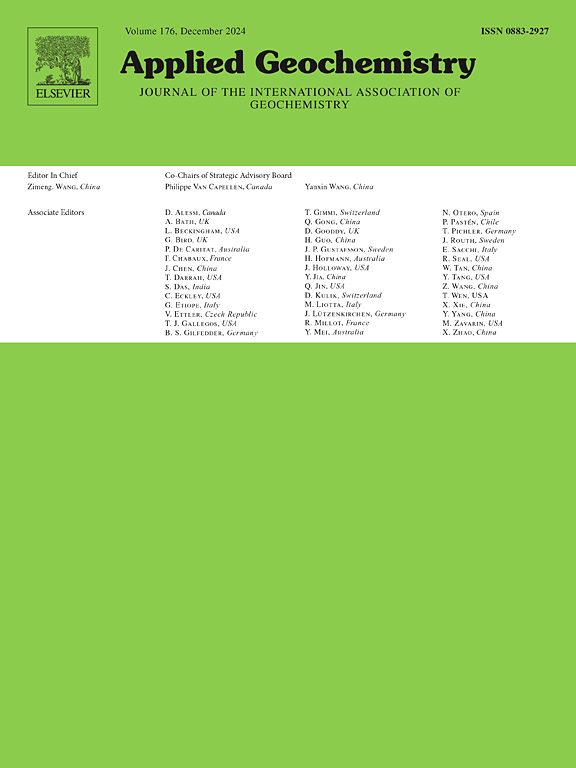Understanding water–rock interaction in crystalline shield fluids using calcium isotopes
IF 3.1
3区 地球科学
Q1 GEOCHEMISTRY & GEOPHYSICS
引用次数: 0
Abstract
Calcium isotopes provide a potentially robust tool for understanding the evolution of crystalline shield fluids, but previous applications have focused on near surface groundwaters. The tendency of Ca isotopes to be affected by mass-dependent fractionation during processes such as water–rock interaction provides a powerful tool for studying the evolution and origin of groundwaters hosted in crystalline rocks. We report Ca isotope ratios (δ44/40Ca) of deep fluids (>300 m) from across the Canadian Shield and integrate these with Sr and Br isotope values to understand long-term fluid–rock interactions in crystalline shield environments. Ca isotope ratios have a wide range of values from 0.07‰ to 0.86‰. At individual sites, δ44/40Ca values are variable whereas 87Sr/86Sr ratios are relatively constant. Sr isotope ratios (87Sr/86Sr) have a negative relationship with the Ca vs. Na content of the fluid indicating different host-minerals contributing Sr to the fluid. Ca isotope fractionation was caused by metamorphic reactions and by the growth and dissolution of Ca-rich fracture-filling minerals. The δ44/40Ca signatures of these processes are overprinted by radiogenic ingrowth of 40Ca by decay of 40K, which is expected to affect older and more K-rich rocks. At one site, δ44/40Ca and δ81Br variability reflects gas-generating reactions in the fluid and/or water–rock interaction processes. These new results demonstrate the strength of combining multiple isotope analysis to elucidate the sources of groundwater salinity and decipher the complex long-term processes that occur in crystalline shield environments.
利用钙同位素了解结晶护盾流体中水与岩石的相互作用
钙同位素为了解晶体屏蔽流体的演变提供了一种潜在的有力工具,但以前的应用主要集中在近地表地下水方面。在水与岩石相互作用等过程中,钙同位素往往会受到质量分馏的影响,这为研究结晶岩中地下水的演化和起源提供了有力的工具。我们报告了加拿大地盾地区深层流体(>300 m)的钙同位素比值(δ44/40Ca),并将其与锶和硼同位素值相结合,以了解结晶地盾环境中长期的流体-岩石相互作用。钙同位素比值范围很广,从 0.07‰ 到 0.86‰。在个别地点,δ44/40Ca 的值是变化的,而 87Sr/86Sr 的比值则相对恒定。Sr 同位素比值(87Sr/86Sr)与流体中 Ca 和 Na 的含量呈负相关,表明流体中含有不同的主矿物 Sr。钙同位素分馏是由变质反应以及富含钙的裂缝填充矿物的生长和溶解造成的。这些过程的δ44/40Ca特征被40K衰变产生的40Ca放射性增长所覆盖,预计这将影响到更古老和富含K的岩石。在一个地点,δ44/40Ca和δ81Br的变化反映了流体和/或水-岩石相互作用过程中的气体生成反应。这些新结果证明了结合多种同位素分析来阐明地下水盐度来源和破解结晶屏蔽环境中复杂的长期过程的优势。
本文章由计算机程序翻译,如有差异,请以英文原文为准。
求助全文
约1分钟内获得全文
求助全文
来源期刊

Applied Geochemistry
地学-地球化学与地球物理
CiteScore
6.10
自引率
8.80%
发文量
272
审稿时长
65 days
期刊介绍:
Applied Geochemistry is an international journal devoted to publication of original research papers, rapid research communications and selected review papers in geochemistry and urban geochemistry which have some practical application to an aspect of human endeavour, such as the preservation of the environment, health, waste disposal and the search for resources. Papers on applications of inorganic, organic and isotope geochemistry and geochemical processes are therefore welcome provided they meet the main criterion. Spatial and temporal monitoring case studies are only of interest to our international readership if they present new ideas of broad application.
Topics covered include: (1) Environmental geochemistry (including natural and anthropogenic aspects, and protection and remediation strategies); (2) Hydrogeochemistry (surface and groundwater); (3) Medical (urban) geochemistry; (4) The search for energy resources (in particular unconventional oil and gas or emerging metal resources); (5) Energy exploitation (in particular geothermal energy and CCS); (6) Upgrading of energy and mineral resources where there is a direct geochemical application; and (7) Waste disposal, including nuclear waste disposal.
 求助内容:
求助内容: 应助结果提醒方式:
应助结果提醒方式:


